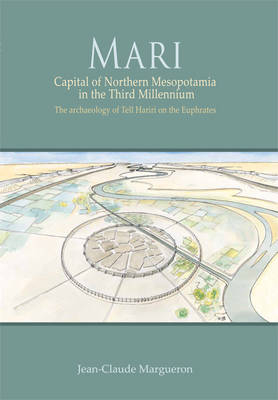
Mari
Oxbow Books (Verlag)
978-1-78297-731-5 (ISBN)
- Titel ist leider vergriffen;
keine Neuauflage - Artikel merken
According to archaeological evidence gleaned over more than 70 years, Mari appears to have been the most important city in northern Mesopotamia from its foundation at about 2950 BC to 1760 BC. Situated at the heart of a river system and progressively linked with an overland network, Mari was the city that controlled the relations of central and southern Mesopotamia with the regions bordering the Taurus and Zagros mountains to the north and east and the Mediterranean coastal zone to the west. Mari drew its power from this situation, and the role it played accounts for the particularity of its features, positioned as it was between the Syrian, Assyrian, Iranian, Babylonian and Sumerian worlds.
The evidence shows that there was not one city of Mari, but three successive cities, each having specific features, although there is a striking permanence in the original forms. The first, City I, founded in about 2950 BC, was based on remarkable principles of city planning, including a broad regional development with the creation of canals for irrigation and transport, one more than 120 km long. In the 23rd century BC City II was founded using impressive technology in city planning. Probably destroyed by Naram-Sin of Akkad about 2200 BC, it was entirely reconstructed as City III by a new dynasty, the Shakkanakku. In the 19th century BC this was replaced by an Amorite dynasty, which ruled until Hammurabi of Babylon destroyed Mari in 1760 BC. The diversity of the information and material that has been recovered confirms Mari’s place as one of the best sources for understanding the brilliant Mesopotamian civilisation that developed between the beginning of the 3rd and the end of the 1st millennium BC.
Jean-Claude Margueron is a hugely experienced and distinguished Near Eastern archaeologist who was Director of the excavations at Mari from 1979-2004 with the Ecole Pratique des Hautes Etudes.
Preface
Acknowledgements
Chapter I: Presentation of the site
The tell
The environment
History of the archaeological exploration
Operations in the main excavation areas
Conclusion: the history of Mari illuminated by archaeology
Chapter II: The foundation of Mari and regional development
The foundation of the city on the Holocene terrace
The canals
Organization of the kingdom of Mari
Chapter III: The historical stages
The foundation of Mari and City I (Early Dynastic I-II, 2950-2650[?])
The re-foundation of Mari and City II (Early Dynastic III and Akkadian 2550-2220)
The reconstruction of Mari and City III (Shakkanakku and Amorite periods, 2200-1760)
Chapter IV: The three cities and urbanism
Morphological analysis of the tell
The defensive system and its development
The urbanism of City I
The urbanism of City II
The urbanism of City III under the Shakkanakku
The modifications of the Amorite period
Chapter V: The development of domestic architecture
The houses of City I
Urban domestic architecture in City II
Houses and residences in City III
Chapter VI: The religious monuments
The religious organisation of City II
The Mari model of the temple in City II
The Massif Rouge and its temple-tower
Activity in the temples of City II
The religious reorganisation of City III
From City II to City III: maintaining tradition
The innovations of City III
Development of foundation rites from City I to City III
Conclusion: originality of the sacred architecture at Mari
Chapter VII: The palaces
The palace-sanctuary of City II
The“phantom” palace (beginning of City III)
The Great Royal Palace of City III
The Little Eastern Palace of City III
Chapter VIII: The development of funerary practices
Burials in City I
Burials in City II
Burials in the period of the Shakkanakku
Burials during the Amorite dynasty
Burials in the Khana period
Burials in the Middle Assyrian period
Burials in the village of the Seleucid period
Chapter IX: Objects and installations of everyday life
Nature of the material found
Importance of economic activities and artisanal production
The intensity of relations and contacts woven by Mari
Chapter X: Court art, sacred art, popular art
Art in the period of City I
Art in the period of City II
Art in the period of the Shakkanakku (beginning of City III)
Art in the period of the Amorite dynasty
Art in the Middle Assyrian period
Chapter XI: The historical data provided by archaeology
Glossary
Bibliography
| Erscheint lt. Verlag | 17.12.2014 |
|---|---|
| Zusatzinfo | b/w illustrations |
| Verlagsort | Oxford |
| Sprache | englisch |
| Maße | 210 x 297 mm |
| Einbandart | gebunden |
| Themenwelt | Geisteswissenschaften ► Archäologie |
| Geschichte ► Allgemeine Geschichte ► Vor- und Frühgeschichte | |
| ISBN-10 | 1-78297-731-7 / 1782977317 |
| ISBN-13 | 978-1-78297-731-5 / 9781782977315 |
| Zustand | Neuware |
| Haben Sie eine Frage zum Produkt? |
aus dem Bereich


